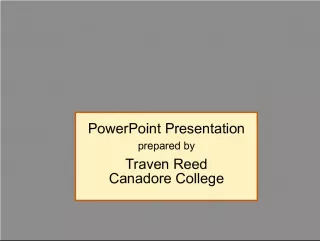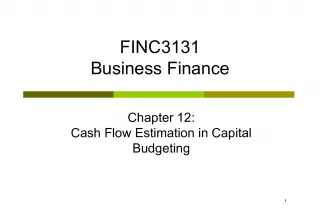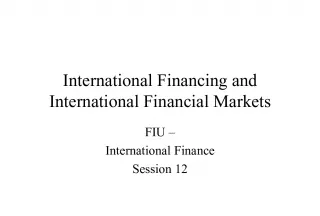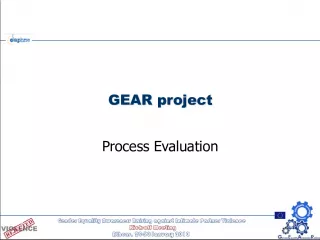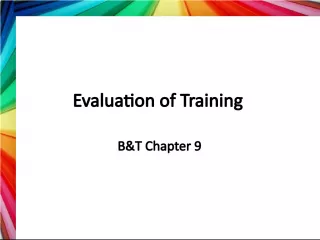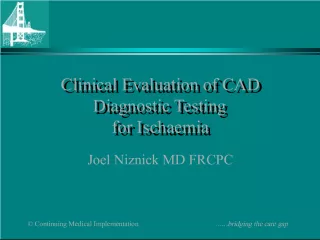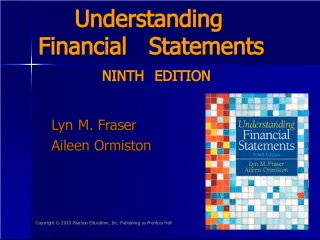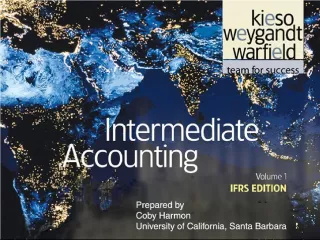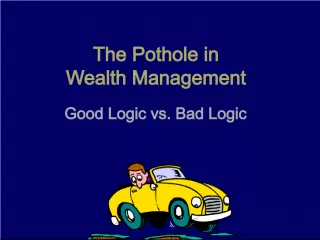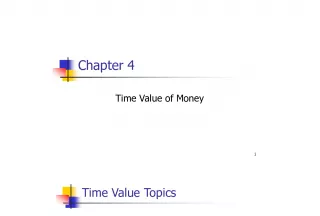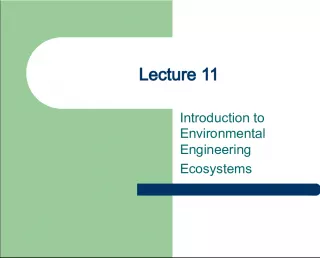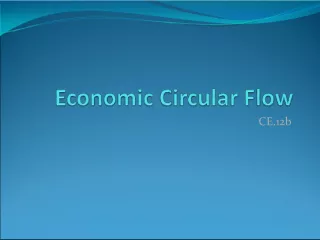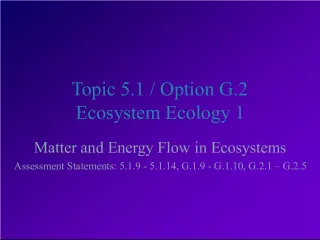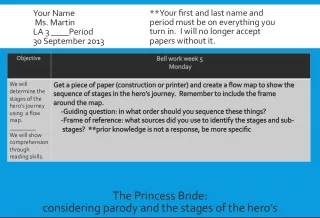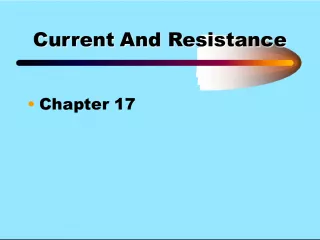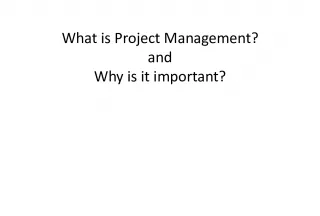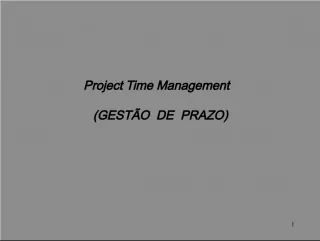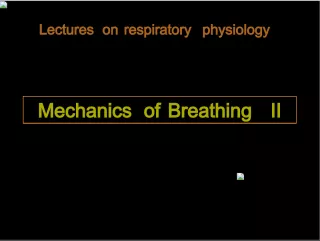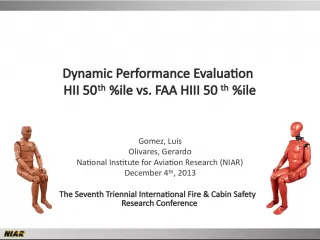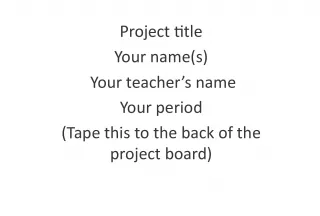Cash Flow Estimation for Project Evaluation


Learn about the step-by-step procedure to estimate cash flows, including initial investment, operating and non-operating cash flows, and guidelines to ensure incremental cash flows are considered. Apply NPV and other methods for project evaluation.
- Uploaded on | 3 Views
-
 jack
jack
About Cash Flow Estimation for Project Evaluation
PowerPoint presentation about 'Cash Flow Estimation for Project Evaluation'. This presentation describes the topic on Learn about the step-by-step procedure to estimate cash flows, including initial investment, operating and non-operating cash flows, and guidelines to ensure incremental cash flows are considered. Apply NPV and other methods for project evaluation.. The key topics included in this slideshow are . Download this presentation absolutely free.
Presentation Transcript
1. 1 CHAPTER 11 Cash Flow Estimation
2. 2 Topics Estimating cash flows: Initial investment Operating cash flows Non-operating cash flows
3. 4-step procedure Initial investment outlay Operating cash flows in the following years Non-operating cash flows in the last year apply NPV and other methods to evaluate the project 3
4. 4 Estimating cash flows guidelines 1 All project cash flows must be incremental For initial outlay Include opportunity costs Include changes in net working capital Ignore sunk costs
5. Estimating cash flows guidelines 1 All project cash flows must be incremental For operating cash flow Include opportunity costs Add back depreciation to net income Ignore interest expense Ignore allocated costs 5
6. Estimating cash flows guidelines 3 All project cash flows must be incremental non-operating cash flows in the last year 6
7. 7 All cash flows must be incremental To evaluate a project, we look at the cash flows which it contributes towards the firms existing cash flows. In other words, we look at projects incremental cash flows.
8. 8 Opportunity costs wrt initial outlay Suppose the project requires the use of some asset owned by the firm. If the asset is not used by the project, the firm can sell the asset for $X. This $X is the opportunity cost of the asset. Such a cost should be included in the projects cost. An assets opportunity cost is the money that the firm can receive if the asset is put to the next best use. The next best use may be to sell the asset.
9. 9 Changes in net working capital Very often, a project will require an initial increase in net working capital. This increase in net working capital must be added to the projects costs. ( changes in AR, Inv, AP, accruals, minimum cash balance ) This additional working capital is recovered at the end of the projects life, which is a non- operating cash inflow in the last year.
10. Sunk costs 1 costs which cannot be recovered regardless of whether the firm undertakes the project. Examples: R&D expenses, consultant fees incurred already 10
11. 11 Sunk Costs 2 Suppose $100,000 had been spent last year to improve the production line site. Should this cost be included in the analysis? NO. This is a sunk cost.
12. Cannibalization Net sales after cannibalization If the new product line would decrease sales of the firms other products by $50,000 per year, would this affect the analysis? Yes. Net CF loss per year on other lines would be a cost to this project. 12
13. 13 Depreciation Depreciation is a non-cash charge and must be added to net income to estimate cash flow. Operating Cash flow = net income + depreciation expense
14. 14 Opportunity Costs wrt operating cash flows Suppose the plant space could be leased out for $25,000 a year. Would this affect the analysis? Yes. Accepting the project means we will not receive the $25,000. This is an opportunity cost and it should be charged to the project. After-tax opportunity cost = $25,000 (1 T) = $15,000 annual cost.
15. 15 Ignore allocated costs Allocated costs: current rent, supervisory salaries, administrative costs, and various overhead expenses. These costs are not incremental. Thus, they should not be considered in estimating the projects incremental cash flows.
16. 16 Ignore interest expense WACC includes the interest expenses. In determining a projects cash flows, we ignore its financing cost, i.e., the interest expense.
17. Non-operating cash flows The incremental net working capital at t=0 is recovered at the end of the projects life, which is a non-operating cash inflow in the last year. After-tax salvage value 17
18. 18 After-tax salvage cash flow Salvage Value $25 - Book Value 0 Gain or loss $25 - Tax(40%) 10 $15
19. 19 Question 1 Thompson Company has to decide whether to build a new factory. Management has collected various cost data to use to make the decision. Some of the items collected are listed below. Which of the following should Thompson consider as being relevant for computing cash flows for the new factory project? A. $500,000 was spent last year to upgrade a piece of property on which the company is planning to build the new factory. B. It will cost $10,000,000 to construct the factory and new equipment costing $3,250,000 will need to be purchased and installed to begin production of the product to be sold. C. The factory construction costs of $10,000,000 will be financed entirely with new long-term debt (specifically a new bond issue). The company estimates that the interest costs of this new debt will be $850,000 per year. D. The variable cost of production is estimated to be 65% of annual sales. E. The accounting department plans to allocate supervisory and management costs of $25,000 per year to the project. No new supervisory or management personnel will be required.
20. 20 Question 2 Investment in land and building: 200,000 Changes in net working capital: 8,000 increase in inventory, 3,500 increase in minimum cash balance, 18,000 increase in account receivable, 2,500 increase in account payable, 500 increase in accruals. The total amount will be recovered at the end of life of project. What is the initial change in net working capital? Answer: 8000+3500+18000-2500-500=26,500
21. 21 Capital budgeting example 1 You are given the responsibility of conducting the project selection analysis in your firm. You have to calculate the NPV of a given project. The appropriate cost of capital is 12 percent and the firm is in the 30 percent tax bracket. You are provided the following pieces of information regarding the project:
22. 22 Details The project is going to be built on a piece of land that the firm already owns. The market value of the land is $1 million. If the project is undertaken, prior to construction, an amount of $100,000 would have to be spent to make the land usable for construction purposes. In order to come up with the project concept, the company had hired a marketing research firm for $200,000. The firm has spent another $250,000 on R&D for this project.
23. 23 Details The project will require an initial outlay of $20 million for plant and machinery. The sales from this project will be $15 million per year of which 20 percent will be from lost sales of existing products. The variable costs of manufacturing for this level of sales will be $9 million per year. The company uses straight-line depreciation. The project has an economic life of ten years and will have a before-tax salvage value of 3 million at the end.
24. 24 Details Because of the project the company will need additional working capital of $1 million which can be liquidated at the end of ten years. The project will require additional supervisory and managerial manpower that will cost $200,000 per year. The accounting department has allocated $350,000 as allocated overhead cost for supervisory and managerial salaries.
25. 25 Calculate initial cost Initial cost is the sum of: Market value of land: $1 mil (opportunity cost) Land improvement $100 k Plant & machinery: $20 mil Incremental working capital: $1 mil Initial cost = 1,000,000 + 100,000 + 20,000,000 + 1,000,000 = $22,100,000
26. 26 Calculate the annual incremental cash flow: step 1 Calculate the annual depreciation expense For this project, fixed assets refer to $20mil plant & machinery. Therefore, Depreciation = (20,000,000 3,000,000)/10 = $1,700,000 Calculate incremental sales Incremental sales = 0.8 x 15,000,000 = $12,000,000
27. 27 Calculate the annual incremental cash flow: step 2 Draw up the incremental income statement Incremental sales 12,000,000 Less Incremental variable cost 9,000,000 Less Incremental managerial salaries 200,000 Less Incremental depreciation 1,700,000 Equals Incremental taxable income 1,100,000 Less Incremental tax @30% 330,000 Equals Incremental net income 770,000 Add back depreciation 1,700,000 Incremental cash flow $2,470,000
28. 28 Step 3: non-operating cash flows At the end of projects life (t=10), company Recovers $1 mil additional working capital (item 9) Receives $3x(1-0.3)=2.1 mil after-tax salvage value from plant & machinery (item 8) Additional cash flows at end of project = 1,000,000 + 2,100,000 = $3,100,000
29. 29 Step 4 CF0 (initial cost) = $22,100,000 Annual incremental after-tax cash flow (Year 1 through Year 10) = $2,470,000 Nonoperating cash flow in Year 10 = $3,100,000 So in year 10, the company receives a total of = 2,470,000 + 3,100,000 = $5,570,000
30. 30 Step 4 To compute NPV, enter cash flows in this way: CF0 = -22,100,000 C01 = 2,470,000, F01=9 C02 = 5,570,000, F02=1 Then press NPV, enter I = 12, press CPT and NPV. NPV = -$7,145,832.09 Decision: reject the project.
31. 31 Capital budgeting example 2 ABC Corp. manufactures television sets and computer monitors. The company is considering introducing a new 40 flat screen television/monitor. The companys CFO has collected the following information about the proposed product.
32. 32 Details 1) The project has an anticipated economic life of 5 years. 2) The company will have to purchase a new machine to produce the screens. The machine has an up front cost (t = 0) of $4,000,000. The machine will be depreciated on a straight-line basis over 5 years. The company anticipates that the machine will last for five years and then have no salvage value (that is, it will be worthless).
33. 33 Details 3) If the company goes ahead with the proposed product, it will have to increase inventory by $280,000 and accounts payable by $80,000. At t = 5, the net working capital will be recovered after the project is completed. 4) The screen is expected to generate sales revenue of $2,000,000 the first year; $4,500,000 the second through fourth years and $3,000,000 in the fifth year. Each year the operating costs (excluding depreciation) are expected to equal 50% of sales revenue.
34. 34 Details 5) The companys interest expense each year will be $350,000. 6) The new screens are expected to reduce the sales of the companys large screen TVs by $500,000 per year. 7) The companys cost of capital is 12%. 8) The companys tax rate is 30%.
35. 35 Questions What is the initial investment for the project? What is the 3 rd year expected incremental operating cash flow? (i.e., the incremental after tax cash flow) What is the 5 th year incremental non- operating cash flow?
36. 36 Q1: initial investment To answer Q1, you need points 2 & 3. Initial investment = machine cost + change in net working capital = 4,000,000 + (change in current assets change in current liabilities) = 4,000,000 + (280,000 80,000) = $4,200,000
37. 37 Q2: 3 rd incremental operating cash flow To answer Q2, you need points 2,4,6,8. Steps: 1) Incremental sales = 4,500,000 500,000 = 4,000,000 2) Annual depreciation = (4,000,000)/5 = 800,000 3) Incremental operating cost for 3 rd year = 0.5 x 4,500,000 = 2,250,000 Next, draw up the incremental income statement
38. 38 Incremental sales 4,000,000 Less Incremental operating cost 2,250,000 Less Incremental depreciation 800,000 Equals Incremental taxable income 950,000 Less Incremental tax @30% 285,000 Equals Incremental net income 665,000 Add back depreciation 800,000 Incremental cash flow $1,465,000 Q2: 3rd incremental operating cash flow
39. 39 Q3: 5 th year incremental non-operating cash flow Very simple. The only incremental non- operating cash flow is the cash flow from liquidating the increase in net working capital (point 3). 5 th year incremental non-operating cash flow = $200,000
40. Homework assignment Problems: 1, 2, 3, 7. 40
